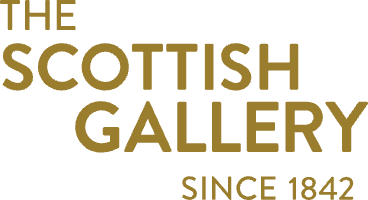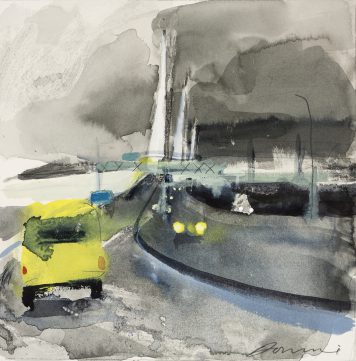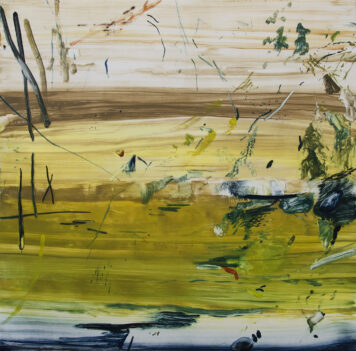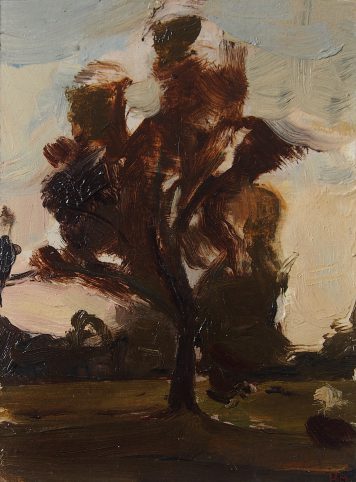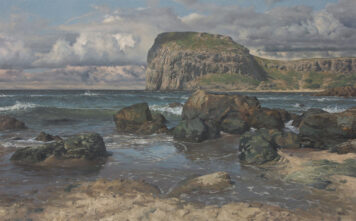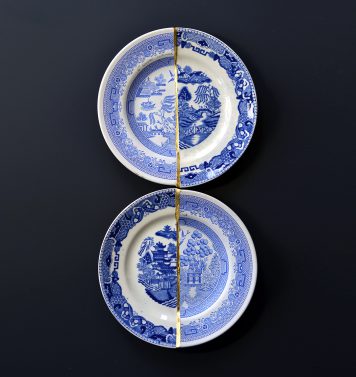Beaufort 12 – Eshaness – ‘white with driving spray’, 2018
Looking West from Quarryford House, East Lothian, 28.vii.2005
Scott’s Cumbrian Blue(s), Landscape,Wil Low, Wil Low, 2018

‘I work with both paint and clay to make multidimensional imagery which reflects on the global, transcultural nature of myths and ceramic archetypes.’ Stephen Bird
Stephen Bird was born in Stoke-on-Trent in 1964 and has lived in Australia since 1999 after graduating from Duncan of Jordanstone College of Art in Dundee. Making his home and a significant international reputation from New South Wales, Australia, he works with both paint and clay. His work is exhibited both nationally and internationally and he has won both The Gold Coast International Ceramic Award and the Deacon University Small Sculpture Award. His use of words, collage and found objects as part of the final work, results in powerful multi-dimensional imagery which reflect on the global, transcultural nature of myths and ceramic archetypes.
I believe visual art is all about humanity’s relationship to objects and I wish above all to invoke the emotional connections which are felt towards things that have been made by hand with love. I create narratives which explore hybrid identities and transgressive themes such as taboos, cruelty, war, natural disasters, unnatural affections and violent deaths. My works are located in the extremes of the tragicomic tradition. I reinterpret old stories both remembered and imagined and appropriate iconography from established pottery traditions; a decorative Royal Doulton tile, or the cabbage leaf from a Wedgwood Whieldon teapot. I am particularly interested in Staffordshire ceramic figure groups from the 18th century which contain implicit meanings and I often try to decipher their hidden meanings and reimagine these in explicit ways. Stephen Bird
Public collections include:
National Gallery of Australia, Canberra; Art Gallery of South Australia, Adelaide; National Museums Scotland, Edinburgh; National Museums Northern Ireland; The McManus Art Gallery & Museum, Dundee

Cook was born in 1957 in Dunfermline and attended Duncan of Jordanstone College of Art in Dundee from 1979-84. He was recognised early as an exceptional talent, winning the first prize at the annual student show at the Royal Scottish Academy in 1983. He then won a travel award which took him to Paris, Amsterdam, Belgium and Cyprus. He won the Guthrie Award at the RSA in 1985 and was given Scottish Arts Council Awards in 1985, 1988 and 1989. He has exhibited irregularly but notably at The Traverse Theatre in 1982 and with the 369 Gallery throughout the following decade.
In the 1990s he was already visiting Seagreens (his current home) and staying at a cottage at Benholm, two miles to the North also frequented by Alberto Morocco and Ian Eadie. Cook travelled regularly in these years to Turkey, the Balearics and significantly, at the invitation of the Everard Reed Gallery, to Southern Africa for three months in 1997. He was able to secure the tenancy at Seagreens shortly after his return and eventually bought it in 2004. This sense of belonging is now deeply embedded; he can see the seasons change and paint the whole calendar; the daffodils of Spring, wild flowers of Summer, the Autumn skies and bleak drama of Winter are all on show: immediate, raw and compelling.

Victoria Crowe studied at Kingston School of Art from 1961-65 and at the Royal College of Art, London, from 1965-68. At her postgraduate show, she was invited by Sir Robin Philipson to teach at Edinburgh College of Art. For thirty years she worked as a part-time lecturer in the School of Drawing and Painting while developing her own artistic practice. She lives and works in West Linton, Edinburgh, and Venice. Her first one-person exhibition, after leaving the Royal College of Art, was in London and she has subsequently gone on to have over fifty solo shows.
Victoria Crowe’s first solo exhibition at The Scottish Gallery was in 1970. In August 2018, we held a major exhibition of paintings at The Scottish Gallery. This coincided with The Scottish National Portrait Gallery’s retrospective of Victoria Crowe’s portraits. In 2019 The City Art Centre held a retrospective entitled 50 Years of Painting. This exhibition embraced every aspect of Crowe’s practice and featured over 150 pieces.
Victoria Crowe is a member of the Royal Scottish Academy (RSA) and the Royal Scottish Society of Painters in Watercolours (RSW). She has exhibited nationally and internationally and undertaken many important portrait commissions, including RD Laing, Peter Higgs and Jocelyn Bell Burnell. She has received many bursaries and research awards and her work is held in numerous public and private collections worldwide.
In 2000, her exhibition A Shepherd’s Life, consisting of work selected from the 1970s and 80s, was one of the National Galleries of Scotland’s Millennium exhibitions. It received great critical acclaim. The exhibition toured Scotland and was re-gathered in 2009 for a three-month exhibition at the Fleming Collection, London. Victoria was awarded an OBE for Services to Art in 2004 and from 2004-2007, she was appointed Senior Visiting Scholar at St. Catherine’s College, Cambridge. The resulting work, Plant Memory, was exhibited at the Royal Scottish Academy in 2007 and subsequently toured Scotland. In 2009 she received an Honorary Degree from The University of Aberdeen and in 2010 was elected a Fellow of the Royal Society of Edinburgh.
In 2013, Dovecot Studios wove a large-scale tapestry of Victoria’s painting Large Tree Group. This collaborative tapestry was acquired for the National Museums Scotland. In 2015, Victoria was an invited artist at Dumfries House and in 2016 a group of work by the artist was acquired by the National Galleries of Scotland. Victoria was commissioned by the Worshipful Company of Leathersellers’ in 2014, to design a forty-metre tapestry for their new hall in the city of London, which took over three years to weave and was installed in January 2017. Dovecote worked with Victoria Crowe to produce a new tapestry inspired by a detail from her painting Twilight, Venice, 2014. The new tapestry, Richer Twilight, Venice was completed and unveiled at the end of September 2019.

Kate Downie was born in North Carolina but raised from the age of 7 in Scotland. She studied at Gray’s School of Art in Aberdeen before travel and residencies took her to the United States, England, Amsterdam, Paris and Japan. Her constant search for new challenges and inspirations has seen her set up studios in such diverse places as a brewery, an oil rig, and an abandoned Hydroponicum.
As a Landscape painter her subject matter is often the man-made rather than the natural, but it is defined by good draughtsmanship and a sense of movement.
‘One of my creative concerns is to define these spaces between buildings rather than the buildings themselves. The object lesson for me is the witnessing and the drawing of these nonplaces which are also, by definition, public arenas of cumulative activity. My job as an artist is to accommodate these actions in our contemporary lives, and to find the poetry within.’
– Kate Downie

Martin Greenland was born in Yorkshire and studied at Exeter College of Art. He has lived and worked in Cumbria since 1985. In 2006, Greenland was awarded first prize at the prestigious John Moores Painting Prize, the UK’s largest contemporary painting exhibition held at the Walker Art Gallery, Liverpool. Martin Greenland is primarily a realist painter; his subject is embedded in the North British Landscape, at first familiar yet entirely imagined – in Greenland’s work, a subtle narrative about contemporary Britain quietly emerges.
I rarely come to start any work with the structure or concept fully formed. My paintings can best be described as improvisations. Sometimes strong images which exist somewhere in my head at the beginning form the resulting work. More often these starting forms radically change; the painting finding its own course. This is when I can describe painting itself and watching the landscape come into being and evolving , as exploring , going into new territory. I often find the reason for the painting or its concept, as I am part or often well on the way through. Very often I begin paintings with just pure paint, pretty abstract. I put paint down in fairly spontaneous ways to give me the unexpected which is always there ‘in nature’.
John Hewitt is currently a senior lecturer in illustration with animation at Manchester Metropolitan University. He completed a PhD in 2008, on the subject of contemporary English courtroom sketches. Hewitt’s creative practice switches between the media of drawing and printmaking and subject matter centres around observed events, people, animals, objects and locations – notions of memory are addressed in his detailed work.
His illustrations have been published in books, magazines and newspapers including The Sunday Times, Radio Times, The Guardian, New Statesman, Time Out and Amit. John Hewitt posts a daily drawing on Instagram under the name of w_john_hewitt. In 2005, the Righton Press published a series of drawings and written account of the London bombings of July 7, 2005. Twenty-four of these drawings are on permanent display in the Museum of London. He won the Hugh Casson Prize for drawing at the Royal Academy Summer Exhibition in 2016.
Public Collections include: Victoria & Albert Museum, London, Whitworth Art Gallery, Manchester, Museum of London, British Council, Government Art Collection

Calum McClure was born in 1987 and graduated in Drawing and Painting from Edinburgh College of Art in 2010. He was the winner of the 2011 Jolomo Painting Award, has had five successful exhibitions with The Scottish Gallery and was an invited artist at the Annual Exhibition of the Royal Academy in London in 2012. Recently he has been included in an exhibition of prints at the Royal Academy, London; had work in the major Scottish art societies’ annual exhibitions; had work exhibited at the RA Summer Exhibition; won a prize at the inaugural W Gordon Smith Award for painting; and most recently exhibited two pieces with Flowers Gallery, London.
McClure is a painter who immerses himself in the landscape and in the artistic process of representing it. He understands how paint can convey the poetry of suggestion and is absorbed in the infinite possibilities of the medium. His work evokes atmospheres, especially through the representation of light, shadow and reflections. Some of his images are almost abstract, others quite clearly representational, produced from intense scrutiny of details in the landscape and vistas, views from particular vantage points all with their possibility for further imaginative exploration. He is an artist who dreams as he sees and concentrates deeply as he paints, enabling others who view his work to be transported in a similar way. The images are positive, beautiful and lyrical, those of a precious environment to be nurtured and celebrated.
To view prints by this artists please click here.

When Jock McFadyen had his solo exhibition at the Talbot Rice for the 1999 Edinburgh Festival one reviewer wrote ‘despite his name Jock McFadyen is an English artist…’
McFadyen’s wife Susie Honeyman telephoned The List to ask whereabouts in England Paisley was…
McFadyen was born in Paisley in 1950 and brought up in Renfrew. As a teenager, he attended Saturday morning classes at Glasgow School of Art and in 1966 his family moved to England. He attended Chelsea School of Art from 1973-77 and has lived and worked in London over the last 40 years. He has had over 40 solo exhibitions and his paintings are in 30 public collections including the Tate, British Museum, V&A and Scottish Gallery of Modern Art as well as corporate and private collections in the UK, Europe and the USA. In 1981 he was appointed Artist in Residence at the National Gallery London and in 1991 he made a solo exhibition on the Berlin Wall at the Imperial War Museum London which toured to Kelvingrove Gallery in Glasgow, and the following year he designed sets and costumes for Sir Kenneth MacMillan’s final ballet ‘The Judas Tree’ at the Royal Opera House in London.
McFadyen has a long association with The Scottish Gallery. In the 1980s he exhibited several times with The Gallery’s London branch in Cork Street and the Dundas Street gallery in 1995. In 2005 The Scottish Gallery exhibited the artist’s work in a disused industrial building at Causewayside during that year’s Edinburgh Festival.
Timed to mark McFadyen’s 70th birthday in November 2020, The City Art Centre, Edinburgh opened a major exhibition Jock McFadyen Goes to the Pictures. The exhibition displayed new and existing paintings, paired alongside works from the City Art Centre’s collection.
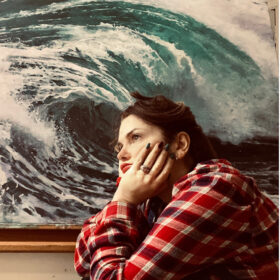
Dawnne McGeachy was born in Campbeltown, Argyll. She graduated from Glasgow School of Art in 1991 and attended the University of Ohio. In 2013, Dawnne won the Jolomo Bank of Scotland award for landscape painting. McGeachy’s dramatic paintings of the sea are inspired by her father’s career as a fisherman on the west coast of Scotland.
Growing up on the peninsula of Kintyre (Campbeltown) I was obsessed by the scale of the ocean, its physicality, poetry and my father’s voyages on it to catch fish. I loved his tales of the stars on a clear night and their use in navigation. However, the flip side of this was being awoken as a child by terrifying wind and rain, knowing that my dad was on the Firth of Clyde on a 45ft skiff. As the child of a fisherman I was aware of what the sea gave but also acutely aware of the cruelty of what it was capable of taking away. I go to the coast as often as I can, largely to build a bank of experiences and photographic reference material for the studio. I often take short films so I can study the movement when I get back to the studio. I love watching the wind drag across the surface, pulling and agitating, making slants and troughs, noticing the troughs get deeper and steeper as they collect the wind and realising this long , rolling swell originated in an ocean storm prior to breaking away from the disturbances of the unsettled sea miles away from the shore and me.

Hannah Mooney was born in Ramelton, Co. Donegal, Ireland and graduated in 2017 from Glasgow School of Art. She has won several awards as a student and since graduating, in recognition of her compelling talent as a painter most recently at the New Contemporaries Exhibition at the Royal Scottish Academy where she won the major Fleming Wyfold Bursary. She currently works in two distinct subjects; still life and the landscape and in both she is an instinctive, natural painter deeply concerned with the matière and traditional composition. Her work has already been acquired for the James Nichol McBroom Archive and the Hottinger Group.
Selected Awards: RSA John-Kinross Scholarship 2017, RSA Landscape Drawing Prize 2017, James Nicol McBroom Memorial Prize 2017, Armour Prize 2017, Selected for Royal Scottish Watercolours Society Exhibition 2018, RSA Galleries, Edinburgh Selected for New Contemporaries Exhibition 2018, RSA Galleries, Edinburgh Hottinger Prize for Excellence 2018, House for an Art Lover Award 2018, Art in Healthcare Prize 2018, Fleming-Wyfold Art Bursary 2018

James Morrison sadly passed away in 2020. He was a great painter and a huge part of The Scottish Gallery for more than sixty years, the last thirty under an exclusive arrangement. His kindness, generosity and loyalty made him a hugely rewarding friend, and it has been a privilege to represent one of Scotland’s most distinctive and brilliant painters.
Born in Glasgow in 1932, Morrison studied at Glasgow School of Art from 1950-4. After a brief spell in Catterline in the early 1960s, Morrison settled in Montrose in 1965, joining the staff of Duncan of Jordanstone College of Art in Dundee the same year. He resigned from Duncan of Jordanstone in 1987 to paint full-time and since then his work has been exclusively available through The Scottish Gallery. Whole-heartedly a landscape painter, his main working areas are the lush, highly-managed farmland around his home in Angus and the rugged wildness of west coast Assynt. As well as Scotland, Morrison has had extended painting trips to Africa, France, and Canada, including three trips to the Arctic in the 1990s. A suite of his Arctic paintings were recently acquired and exhibited as part of a major exhibition, Among the Polar Ice at The McManus in Dundee (September 2019 – March 2020).
James Morrison first exhibited with The Gallery in the fifties. In June 2022, The Scottish Gallery celebrated the life and work of one of Scotland’s most-loved artists in a major retrospective show James Morrison A Celebration 1932 – 2020. The exhibition, held two years after his death, presented work from the entirety of his artistic career which spanned seven decades. A new exhibition Under a Northern Sky opens in The Gallery in April 2024. This show will contain a remarkable collection of Morrison’s Scottish subjects, many drawn from private collections.

I first became aware of Paul Reid’s paintings when I was a lecturer at Duncan of Jordanstone College of Art in the mid-nineties. As part of the first-year course schedule students were asked to make a self-portrait. I remember being very taken with the small head and shoulders self-portrait that Paul produced. The painting had something of the warmth of colouring of Van Dyck and the cool gaze of Velázquez. It showed a precocious talent with serious intent that said to me that this was someone to watch. In the subsequent four years Paul devoured Max Doerner’s The Materials of the Artist and their Use in Painting. He learned to grind pigments and make a paint that had the desired consistency for his works. At the same time Paul also immersed himself in studying Rubens, Van Dyck, Titian and Velázquez, the artists whose techniques he sought to emulate. Paul was painting wonderfully assured realist still life and thoroughly engaging portraits of family and friends. The still life works and portraits were powerfully realistic with an ease of handling that showed his deep understanding of the language of the Master’s he was studying. It was while studying Rubens that Paul became interested in mythological based works. Through studying the titles and names referred to by Rubens he became aware that they referred to Greek myths. In a sense Paul was led to classical mythology by the process of painting itself. Paul began studying Ovid’s Metamorphoses which opened up a vast subject where he could expand, channel and challenge his formidable powers of realistic painting. Paul’s first classically inspired work was a large painting The Death of Actaeon painted in his fourth year. This was a very significant transitional point for Paul: it was where his portraiture, life room studies and still life knowledge were all pulled together into one large successful composition. It was intriguing at the time to leave his studio and see the faces of the characters of his paintings wandering the art school corridors. Paul’s subsequent ongoing body of mythologically inspired paintings have worked so well because of his powers to instil a potent sense of reality. It is not an arcane or unreachable reality but something timeless and tangible. Characteristic of his subsequent works is his ability to impart a vast amount of information without confusing or distracting the viewer. His paintings overflow with visual material: images of fruit and vegetables, costume, portraiture, human form in action, metamorphosis, landscape, architectural details and still life. All of these elements play a part in his highly orchestrated compositions. Derrick Guild
Paul Reid graduated from Duncan of Jordanstone College of Art in 1998 after which he was awarded a Carnegie Trust Vacation Scholarship and a John Kinross Scholarship. In 2004, he accompanied HRH The Prince of Wales on a trip to Turkey and Jordan, completing a series of paintings and drawings based on the landscape and people they visited; a further visit to Canada with HRH followed in 2009. Paul Reid has immersed himself in the techniques of the Renaissance masters and has found his subjects in the potent imagery of the Greek Myths as recorded in Ovid.
Alan Robb was born in Glasgow and brought up in Aberdeen He graduated Grays School of Art in 1969 and from the RoyalCollege of Art, London in 1972. Robb was appointed assistant art master at Oundle School in Northamptonshire and in 1975, relocated to Cork, Ireland as painting tutor at the Crawford School of Art. In 1980 he became head of Diploma Studies and as well as Painting Printmaking and Sculpture, his remit included Art History, Stained Glass and Violin making. In 1983 he was appointed Head of the School of Fine Art at Duncan of Jordanstone College of Art, Dundee and was awarded a personal chair in 1989. Robb retired as Professor Emeritus of the University of Dundee in 2007. He was elected a member of the Royal Scottish Society of Painters in Watercolour in 2010 and a member of the Royal Scottish Academy in 2011.
“As I review my practice and resulting body of work it seems like a speculative circular journey, based almost wholly on intuitive choices and a growing understanding of what I can do. The motivation and momentum comes from unexpected discoveries and the hundreds of small decisions, which give each work its resolved identity.” — Alan Robb
His collection of work Sacred & Profane is a painterly exploration is made of material gathered from churches and museum collections to market stalls and specialist “magic shops” or the artist’s collection of Christian votive figures, Macumba and Candomble figures in wood, metal or plaster. The resolution of each painting is a combination of reference and invention. There is latitude for interpretation as in all popular iconography and religious art, which is where the real interest lies.

Paul Scott lives and works in rural Cumbria. He has been a professional artist for over thirty years and is best known for his research into ceramics and print. He creates individual pieces that are exacting and critical, blurring the boundaries between fine art and design. A leading proponent of ceramics and print, he has been instrumental in demonstrating the contemporary creative potential of a combination used in industry for hundreds of years to mass-produce decorative wares and tiles. In 2010, he designed thirty linear metres of the record breaking Hanoi Mosaic Mural in Vietnam. Confected, Borrowed and Blue… an Installation by Paul Scott toured throughout 2015 – 2016 at various locations throughout the UK.
‘Over the years, my artworks have commemorated and examined a range of issues, from the Foot and Mouth crisis to the impact of energy extraction and production on our environment… I have inserted nuclear and coal fired power stations as well as wind turbines into pastoral landscapes, exploratory oil rigs in pristine arctic locations – and placed landscapes with fracking rigs onto cracked platters. In March 2011, the Fukushima Daiichi nuclear power plant in Japan was enveloped by tidal waves following the Tōhoku earthquake and tsunami. The ensuing events cut power to water-cooling pumps and nuclear fuel rods melted down, creating the largest nuclear disaster since Chernobyl in 1986. Scott’s Cumbrian Blue(s) Fukushima series commemorates the event. All works have been made on Willow pattern platters made in Japan. Although the Willow Pattern was originally made in late eighteenth century Staffordshire to imitate Chinese porcelain wares, it is a jumbled confection of designs with decorative details incorporating elements not only of Chinese porcelain but also Japanese Imari ware. It has been produced all over the world. I collaged an erased piece of an old English Willow pattern platter (c.1840) into the scene. I removed the original print and replaced it with an in-glaze print after Katsushika Hokusai’s woodblock print The Great Wave off Kanagawa (c.1830). The nuclear power plant can be seen behind garden buildings.’ – Paul Scott, 2016
Public and Private Collections include:
Victoria & Albert Museum, London; National Museums Scotland, Edinburgh; Government Art Collection, UK; New York Historical Society, USA; National Museum of Wales, Cardiff; The National Museum Stockholm, Sweden; The National Decorative Arts Museum, Norway; Carnegie Museum of Art, Pittsburgh, USA; Tullie House Carlisle Museum and Art Gallery.
Paul Scott presents a solo exhibition, Scenery, Samplers & Souvenirs, in May 2021. This exhibition presents new artworks which update historical transferwares for the 21st century, including a selection from his New American Scenery series. The exhibition also features work made as a result of his Gardens of Lyra collaboration with Spode and Fortnum & Mason and also presents new works from his Cuttings Series.
